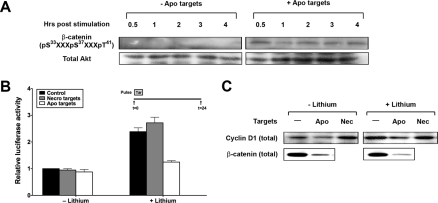FIGURE 10.
Apoptotic targets inhibit β-catenin-dependent transcriptional activity. A, serum-starved BU.MPT responder cells were exposed to vehicle or apoptotic targets (Apo) at a target/responder cell ratio of 10:1 for 30 min. The source of apoptotic targets was staurosporine-treated BU.MPT cells. At the indicated times following stimulation (t = 0), non-adherent cells were removed by washing, and responder cell lysates were probed with anti-phospho-β-catenin antibody as shown. B, to assess β-catenin-dependent transcriptional activity, BU.MPT responder cells were transiently co-transfected with pTopflash and a Renilla luciferase normalization vector. 24 h after transfection, BU.MPT responders in the presence or absence of lithium (40 mm) added 1 h earlier were exposed to apoptotic (Apo) or necrotic (Necro) targets at a target/responder cell ratio of 10:1 as a single 30-min pulse as depicted in the inset. The source of apoptotic targets was actinomycin D-treated DO11.10 cells. 24 h after exposure to targets, luciferase activities of BU.MPT responders were determined. All values were normalized against those for responder cells exposed to neither lithium nor targets. The graph depicts the mean and S.E. from three separate experiments. p < 0.005, apoptotic targets versus control in the presence of lithium. C, BU.MPT responder cells in the presence or absence of lithium (40 mm) were exposed to apoptotic (Apo) or necrotic (Nec) targets at a target/responder ratio of 10:1 continuously for 24 h. The source of apoptotic targets was actinomycin D-treated DO11.10 cells. Targets and non-adherent cells were removed by washing, and BU.MPT responder cell lysates were probed for total cyclin D1 and β-catenin as shown. A and C, equal loading was confirmed by Ponceau S staining of blotted proteins as well as by probing for total Akt. Tar, target(s). Error bars (B) denote S.E.

